In the US, social commerce retail earnings are predicted to reach nearly $80 billion by 2025. Given that 4.89 billion people currently use social media, social commerce is a no-brainer for getting your brand in front of more customers.
But making sure your brand stands out from increasing competition—and boosting your ecommerce sales via social media—is no easy feat. You need a solid understanding of your target audience’s shopping preferences and how you can use social commerce tools to provide a top-quality customer experience.
Here, you’ll learn the latest social commerce trends, statistics, and predictions for 2024. This will help you create a successful social commerce strategy that attracts consumers and drives sales.
What is social commerce?
Social commerce is the use of social media platforms to promote and sell products or services. It lets businesses and customers interact directly, resulting in a seamless shopping experience within the user’s preferred social network. This in turn enhances customer reach, engagement, and conversion rates.
Social commerce presents consumers with a more convenient and interactive shopping experience—which may explain why it’s becoming increasingly popular. Estimates show that the global value of social commerce will reach about $2.9 trillion by 2026.
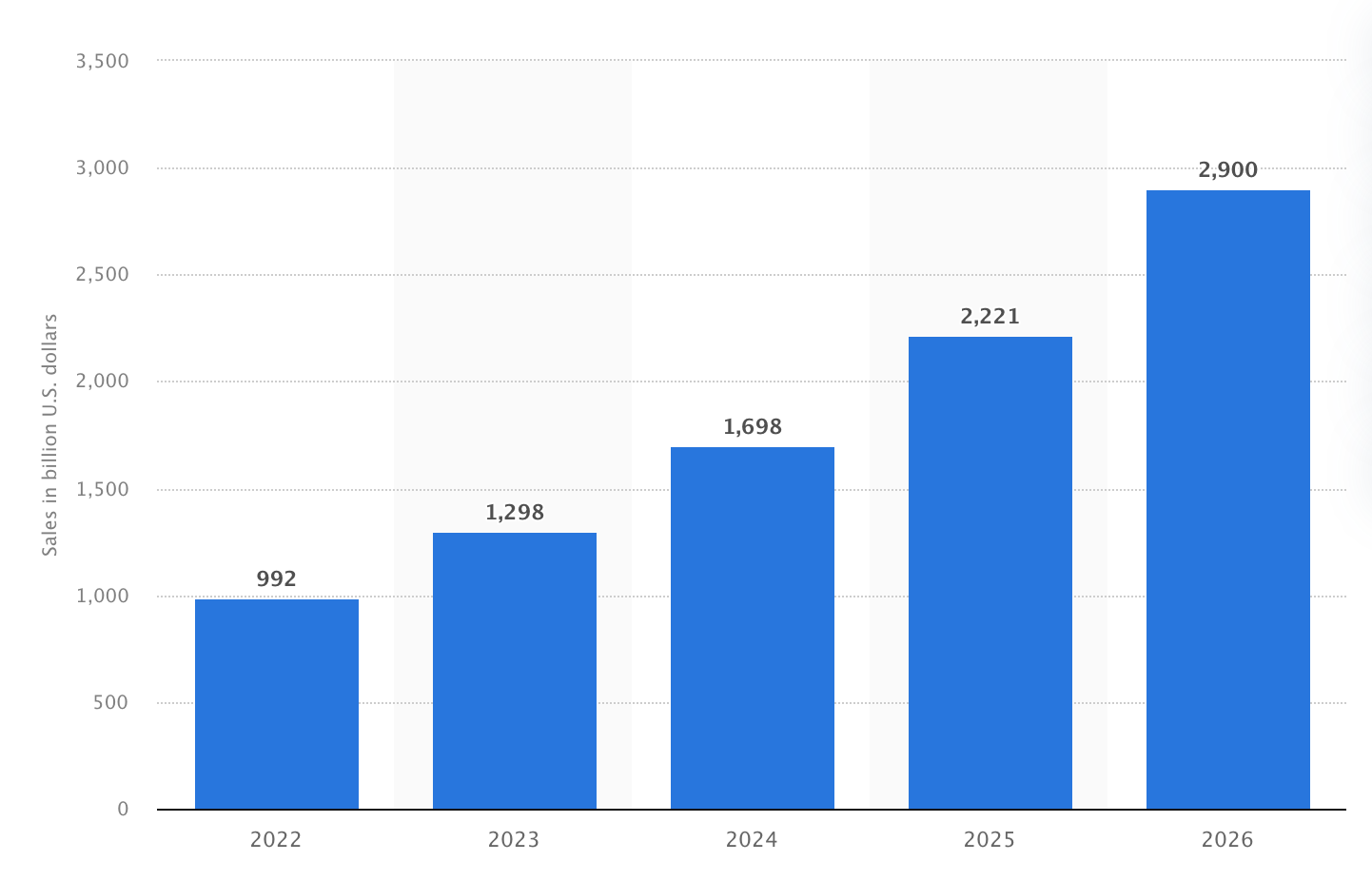
Why is social commerce important?
Social commerce is booming because social media usage is as well. Research shows that the typical social media user now spends about 15% of their waking life on social platforms, with the average user spending 2 hours and 26 minutes each day across an average of 6 social media apps.
People no longer use social media solely to connect with friends—it’s also become a way for brands to promote and sell products. For example, while scrolling on Instagram, you may see a set of skin care products, tap Shop now, add it to your shopping cart, and check out—all within the app.
If you’d previously ruled out social commerce for your small business for fear that your audience is “too old” to use it, studies show that people across all generations engage in social commerce. Nearly a quarter (23.1%) of US social buyers are between the ages of 25 and 34, and more than 52% are over the age of 35.
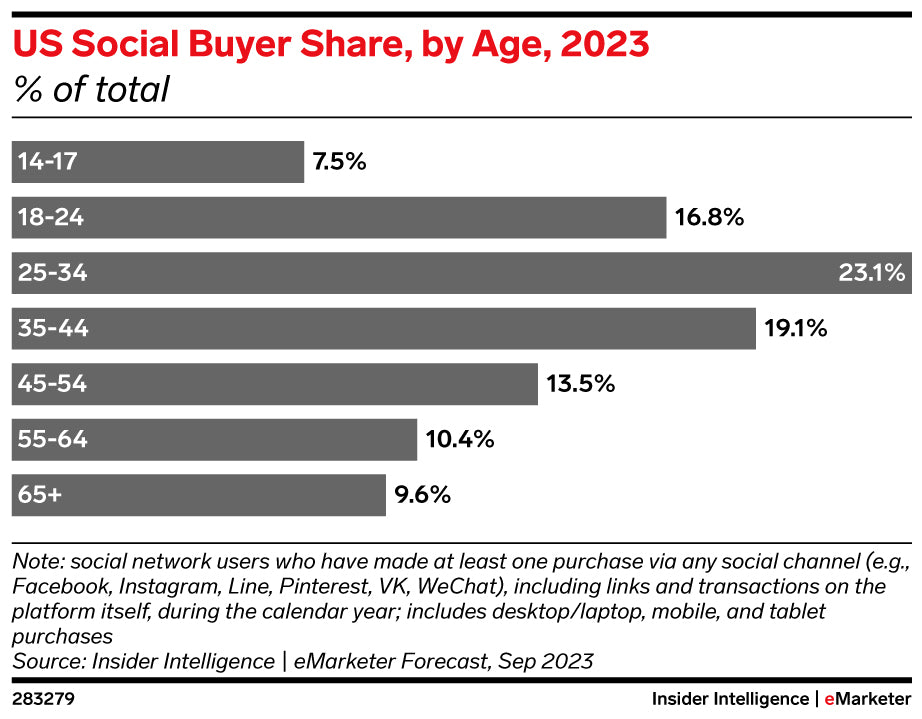
What’s the difference between social commerce and ecommerce?
Social commerce and ecommerce are not the same sales methods, even though both exist online. Ecommerce is a shopping experience that takes place on a website or branded app. These sites are usually built on ecommerce platforms like Shopify. Consumers can access these sites on any internet-enabled device, including a desktop, tablet, or mobile device.
Social commerce, a subset of ecommerce, is the use of social media platforms like Facebook and Instagram to market and sell products and services. This type of selling model lets customers complete purchases without ever leaving their social media apps.
With social commerce, brands can sell products through their social media marketing strategy. There’s no requirement to have their own ecommerce site to get set up with social media platforms’ native selling tools—but online retailers that have a website with an online store can benefit from social commerce by directing leads to their website.
The best social commerce platforms
There are four major social platforms that currently provide native social commerce tools. As the popularity and revenue of social commerce continue to grow, more social media platforms may create their own virtual storefronts.
1. TikTok
TikTok is the new kid on the block, but its rapid growth could fool anyone into thinking it’s been a social commerce platform for ages. The video-sharing platform is predicted to hit 48.8 million US users by 2025, beating Instagram’s 48.2 million, despite the latter’s six-year lead.
But TikTok users aren’t just scrolling through the app to be entertained. Some 43% of Gen Z audiences start their online product searches on TikTok—beating traditional product discovery methods like Google or Amazon. By 2026, there will be an estimated 39.5 million TikTok buyers in the US alone.
TikTok’s official entrance into social commerce came when they partnered with Shopify to launch in-app social shopping in 2021. Merchants with a TikTok for Business account can add shopping tabs to their brand’s profile, showcasing a virtual storefront for users to browse without the friction of exiting the app.
“Advertising with TikTok has ’hockey-sticked’ our growth,” says Tai Adaya, founder of HABIT. “Seriously, we can’t stay in stock! TikTok has allowed us to get in front of the world.”
How to Use TikTok To Build a Multi-Million Dollar Brand | Secret Tips from the CMO of Vitaly
2. Facebook
Facebook is the social commerce platform of choice for the majority (89%) of marketers who use it to drive retail social commerce sales.
Facebook’s popularity is echoed amongst consumers: Statista reports that one-third of social commerce buyers prefer to buy through Facebook. Plus, according to an Insider Intelligence survey, some 62% of US social buyers said their most recent social purchase took place on Facebook, with features like Marketplace and Shops facilitating these transactions.
For brands looking to venture into social commerce, it makes sense to start with a Facebook page—any Facebook Business account can set up a Facebook shop, which is a completely customizable online storefront. Here, brands can upload their product catalog or create one from scratch.
Visitors to a brand’s Facebook profile can view available products, including sizes, color variations, and specifications, and potential customers can ask brands questions directly through Facebook Messenger. Once ready to purchase items, shoppers can use Facebook Checkout without leaving the platform, or brands can redirect them to an online store.
Using the Shopify integration, brands can automatically sync products to Facebook and create shoppable posts and ads. This simplifies the importation process and makes it easy for merchants to bring the look and feel of their Shopify store to Facebook shops.
Brands that are new to social commerce can set up a test shop within Facebook shops, where they can add products, manage orders, and evaluate customer experience.
3. Instagram
Instagram, also owned by Meta, is a behemoth of a social commerce platform. Studies show that almost 26% of the global population over the age of 13 uses Instagram. And according to Instagram, 70% of shoppers use the platform to find their next purchase.
From building brand awareness to providing a better online shopping experience, Instagram is a great way for brands to reach a larger audience and sell more products.
Instagram Shops allow users to buy products shown in images and videos across the app. Similar to Facebook, Instagram Business accounts can showcase their products through a customizable virtual storefront. Here, brands can create curated collections of products. Each item in an Instagram Shop catalog gets its own product page, including pricing, a detailed description, and any photos or videos displaying it.
There are several ways brands can use Instagram Shops to sell their products. Here are some of the platform’s top features:
- Shopping tags: These let brands tag their products in their feed posts and Instagram Stories.
- Shop tab: Here, Instagram users can browse, save, and purchase products displayed by brands or tagged by influencers.
- Ads: Businesses can create Instagram Ads with Shop tab placements too. The ad will show up with a Sponsored label and let users tap through to the storefront or complete product description.
- Shop through DMs: Customers can purchase from businesses through Instagram DMs. Shoppers can ask questions, make purchases, and track their orders.
4. Pinterest
Pinterest is a combined search engine and social media platform for images. Users create mood boards, pin places to travel, and—more importantly—discover new products. More than 465 million people use the platform every month to find ideas and research products.
The best part? The vast majority (97%) of Pinterest searches are unbranded, and 31% of people in the US with a household income over $100,000 are on Pinterest. When merchants upload product listings from their online store to Pinterest, they have the ability to reach potential customers who aren’t aware of the merchant’s products but have the disposable income to splurge on products.
The shoe company Allbirds represents a great example of social commerce on Pinterest. The brand uses shoppable product pins to reach customers through the platform. These listings are optimized both for the brand name and the product type, giving Allbirds the best shot at reaching people using Pinterest’s Shop tab to discover new products.
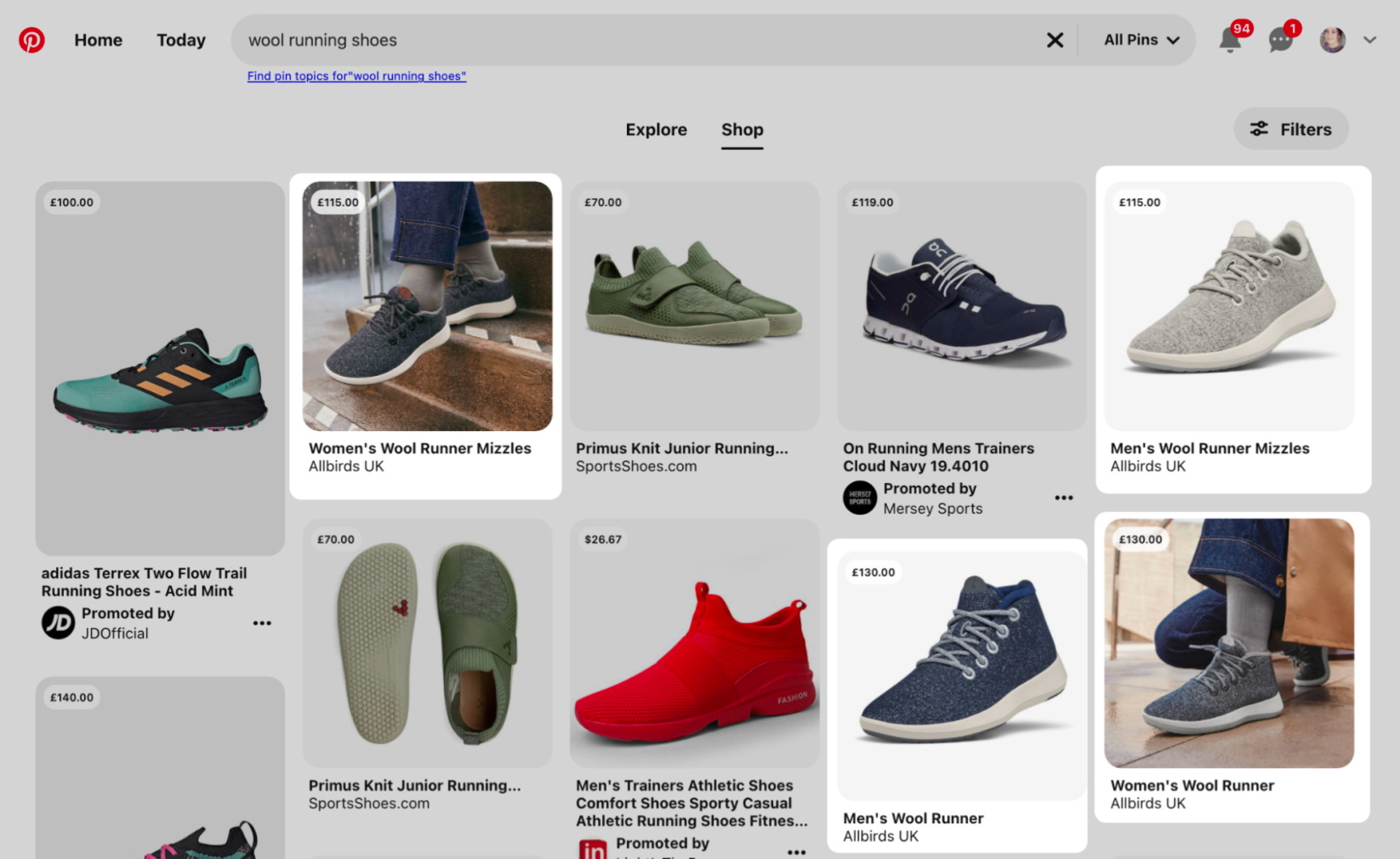
Reasons to try social commerce
In the US, social commerce’s worth is predicted to reach $79.64 billion by 2025. For retail brands interested in using social commerce tools, there’s a large piece of the pie to claim.
Other than the potential boost in ecommerce sales, using social commerce brings retail businesses plenty of other benefits, too.
Here are the top five benefits of social commerce:
- Reach a larger target audience
- Create a frictionless shopping experience
- Gather data on your audience
- Lean into social proof
- Receive customer feedback
1. Reach a larger target audience
In 2024, 5.17 billion people will use social media. This figure is projected to reach 5.85 billion by 2027.
There’s more opportunity than ever before to reach a global audience through a social commerce strategy. Plus, increasing numbers of social media users are starting to shop through social media sites. If your target audience lies in the 18–34 age group, they’re already scrolling and ready to shop.
2. Create a frictionless shopping experience
Functionality like in-app checkout, Buy buttons, and instant messaging tools make shopping through social media convenient.
Social commerce helps eliminate unnecessary hurdles in purchasing. With extra steps in the buying process, customers are more likely to lose interest and abandon purchases, but by letting users stay within the app from discovery to checkout, there’s a lower risk of shoppers abandoning their purchases.
For example, instead of redirecting a Facebook user from the app to your website, their social commerce platform has a “Checkout on Facebook” option. This means shoppers can browse products and purchase them without leaving social media.
3. Gather data on your audience
Social media platforms represent a top source of customer data. This valuable data can inform future marketing campaigns and product development.
Instagram Insights provides demographic data like gender, age group, and geographical location. Using Facebook Audience Insights, marketers can gather even more in-depth data about their target audience. Its demographics overview provides age and gender breakdowns, job titles, relationship statuses, and education levels. Brands can also find out about users’ interests and hobbies.
Using this data, retailers can build highly targeted ad campaigns so their products appear in front of their ideal audience. As a result, social commerce gives brands the chance to connect products with specific and highly targeted audiences in ways that traditional ecommerce sites can’t replicate.
4. Lean into social proof
According to Oberlo, 9 in 10 online shoppers check reviews before purchasing. People need to trust brands before they buy, so they’ll look at past customer reviews, compare products, and even talk to other customers before making a decision.
Social commerce comes with integrated social proof in the form of user-generated content. Comments, likes, shares, and follows all help potential shoppers to trust your brand. When customers keep interacting with and promoting your brand, other social media users are more likely to trust your brand, too.
Brands can incentivize users to share content with giveaways, discount codes, or coupons. Branded hashtags that encourage users to share images or videos of them using products are another way to build social proof.
For example, DTC skin care brand Curology regularly shares customers using their products to build trust with their Instagram audience.
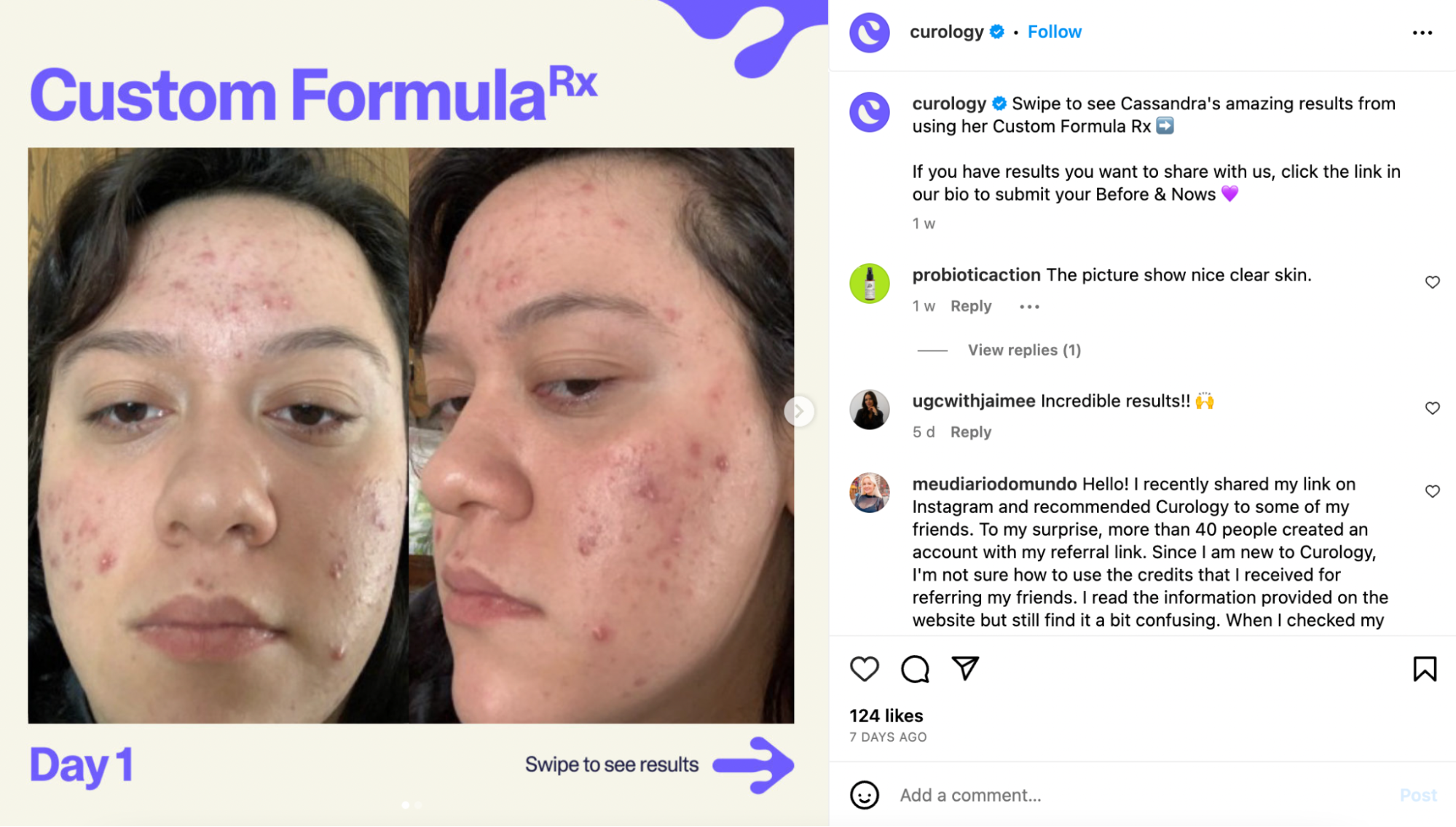
Influencer marketing also helps to build trust and generate social proof. When well-known influencers showcase your products, it increases your brand’s credibility. For instance, 87% of YouTube viewers trust the recommendations that creators provide. Using YouTube Shopping, brands can pin products next to their video so viewers can like, subscribe, and buy.
5. Receive customer feedback
Social media makes it easy to interact directly with customers and get their feedback on your brand and products. Customers love to share their opinions, because it helps them—and by extension, their perspective—feel valued. Brands can use social commerce platforms to run polls, ask customers for their opinions in the comments, and chat through messenger tools.
Using this feedback, retailers can tailor their offerings to meet customer expectations. Whether that’s better customer service, more product size options, or a new clothing collection, once retailers have these insights, they can take action.
Social commerce industry statistics
The social commerce industry is booming—and the future is bright. Here are a few statistics that shed a bit more light on the state of social commerce:
- Fourteen percent of all online purchases happen through social media. This makes social commerce more popular than buying directly from a big-box retailer, delivery app, or DTC store.
- China’s borders house the most digital buyers in the world, and those shoppers’ purchases make up over 50% of all retail sales. According to Statista, 84% of Chinese consumers have shopped on social media platforms—one of the highest figures globally.
- Ninety-one percent of people would like to see more video content from brands. For most social media platforms, video content now takes priority. Take a look at the laundry list of new features released by social media giants over the past few years and you’ll notice one thing they all have in common: a love for video.
- Twenty percent of shoppers have already engaged in live shopping events. While live shopping is still in its earlier stages in the US, livestreamed shopping events have made waves in China. China’s livestream selling market grew from $3 billion to $171 billion in three years. Current estimates suggest that the livestream market will be worth $35 billion in the US by 2024.
- Influencer marketing is a $21.1 billion industry. Despite fears that the pandemic would slow down influencer marketing, it has only fueled further growth. While 67% of brands plan to increase their influencer marketing budgets over the coming year, the type of social media user who fits a brand’s “ideal influencer” criteria is changing: followers are no longer the most important piece of the puzzle. What matters more is a creator’s ability to produce seemingly unbiased content.
Social commerce trends for 2024
We’ll get into each of these in more detail, but here’s a high-level look at where social commerce is headed this year.
- People engage more with AR experiences.
- More video content to showcase products in action.
- Micro-influencers will help brands build authentic reach.
- Livestreaming will increase in popularity.
- User-generated content will build trust among shoppers.
- More brands will use AI-trained, payment-facilitator chatbots.
- Frictionless social shopping experiences will boost customer loyalty.
- Stronger integrations between ecommerce and social commerce platforms.
People engage more with AR experiences
Augmented reality (AR) and virtual reality (VR) are entering the mainstream. In 2024, an estimated 104.3 million Americans will use AR, and close to 73.7 million will use VR. By 2025, 19.8% of these people will access this type of technology via social networks.
Social media is a key driver of AR usage. People often first experience AR when they use a filter or lens in Snapchat, Instagram, or TikTok. Retailers can tap into this trend by using AR filters to demonstrate their products or allow customers to try them on virtually.
Brands can harness social media AR to help customers figure out which products they want to purchase. Instead of relying on customers going to physical stores to try on products, they can use the technology to get a feel for items at home.
For example, home and lifestyle brand Magnolia Market uses Shopify AR to give online shoppers the same experience as retail customers. “Not everyone is able to visit us in person, but it [is] still important to us that the finer details of the in-store experience come through for those shopping online and on the go—augmented reality makes that possible,” says cofounder Stone Crandall.
“With this technology, users can see our products up close to examine the intricacies that make them special and unique. We always want our guests to leave feeling inspired by what they’ve experienced, and thanks to the new Magnolia app, they’ll be able to do just that—no matter where they’re located—from the palm of their hands.”
More video content to showcase products in action
Take a look at the laundry list of new features released by social media giants over the past few years and you’ll notice one thing they all have in common: a love for video. For retail brands, this preference for video content is good news—89% of people say they’ve been convinced to buy a product or service by watching a brand’s video.
TikTok’s video-only platform has dominated the social media landscape at a record-breaking speed. Meta launched Instagram and Facebook Reels, both TikTok rivals, to keep up. Off the back of these changes, consumers are becoming increasingly reliant on video throughout the shopping journey.
Regardless of the video format and channel you use, remember that shoppable videos are still new to some viewers.
Make it obvious that viewers can shop products directly through a post, with captions and frequent reminders. Stick to one or two products per video and show them in action. Film with interactivity in mind, providing clickable calls to action throughout the video that direct your followers to your social storefront. This Instagram Reel by Bushbalm, for example, tags products from their Instagram Shop:
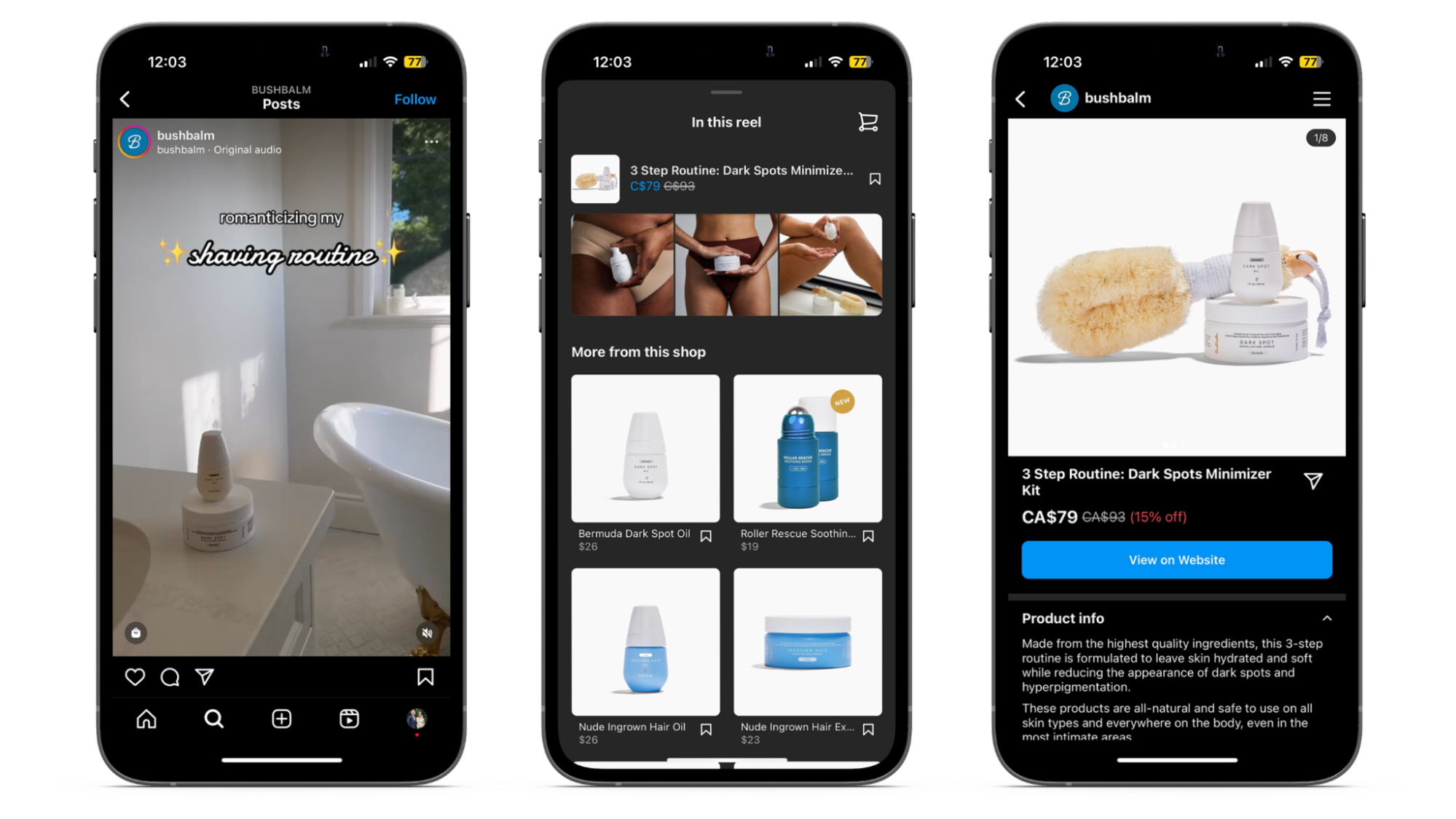
Brands can also take a social-first approach by creating behind-the-scenes livestreams, video consultations, and personalized product recommendations.
How Bushbalm Grew From a $900 Side Hustle into an 8 Figure Business
Micro-influencers will help brands build authentic reach
While working with micro-influencers isn’t a new social commerce trend, it’s still relevant for 2024. Some 81% of consumers trust influencers’ recommendations over a brand’s seemingly biased marketing messages.
While big-name influencers with thousands or millions of followers may be out of reach to some growing retailers, micro-influencers usually work with brands at affordable budgets.
Smaller retail businesses in particular may find that working with micro-influencers makes their marketing budget go further while helping them engage with larger segments of their target audience. For instance, Instagram influencers with fewer than 10,000 followers can charge up to $100 per sponsored post. (No wonder 53% of Gen Z believe influencing is a credible career choice.)
Micro-influencers also have a specific audience type that makes it easier to target different demographics. To followers, these influencers are often seen to be more authentic than accounts with thousands or millions of followers.
Data from HypeAuditor found that nano-influencers—those with fewer than 5,000 followers—have the highest engagement rates (2.53%). This seems to decrease as the follower count skyrockets, until reaching celebrity level (0.92%).
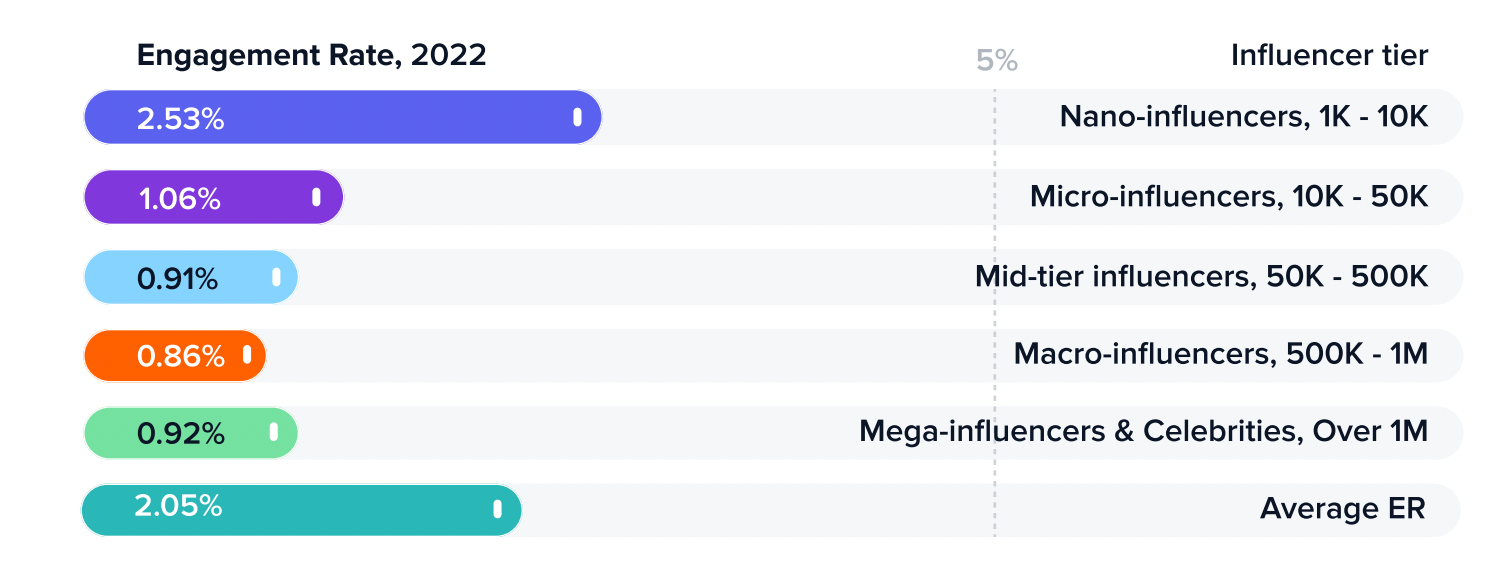
“I think authenticity is really what’s important because, today, a lot of brands pay people to wear stuff, but it looks like it’s paid for,” says Eran Elfassy, founder of Mackage. “Today I would say it’s harder, because influencers and celebrities want a lot of money to wear stuff. Sometimes it could be a spend that you’re probably not going to get a return on. So really find the authentic ones. Go with smaller influencers or smaller celebrities at the beginning, but somebody that really fosters your style and is authentic.”
Cosmetics brand Glossier has a well-established influencer program, where influencers receive product discounts or other non-monetary rewards in exchange for posting images and videos about Glossier products. The focus is on showcasing products influencers enjoy in a natural way.

Livestreaming will increase in popularity
Combine influencer marketing with livestreaming and you’ve got a social commerce storm on your hands.
Live commerce uses social media platforms to blend livestreaming and commerce. Viewers tune into a Facebook Live (or equivalent) video, have real-time communication with a brand, and purchase items based on that communication. Current estimates suggest that the livestream market will be worth $35 billion in the US by 2024.
Retail businesses prepared to tap into livestream shopping can expect large rewards. Brands report live commerce conversion around the 30% mark—that’s 10 times higher than conventional commerce. Plus, they’re experiencing lower product return rates—the biggest thorn in ecommerce merchants’ sides.
User-generated content will build trust among shoppers
Often the most influential content isn’t overly staged product images, but authentic user-generated images from real customers.
Shoppable user-generated content (UGC) can provide the social proof customers want to see before making an in-app purchase. Shoppers can’t physically experience an item when shopping online, but authentic visuals created by customers can provide a view into what a product looks like in reality. Almost 80% of people say UGC highly impacts their purchasing decisions.
Online clothing boutique Lulus regularly posts images of real people wearing their clothes on TikTok. They promote the branded hashtag #lovelulus in its bio as a way to get customers to use it in their posts.
In this UGC example, the brand tags the user and includes the hashtag to show browsers the post was found through the hashtag.
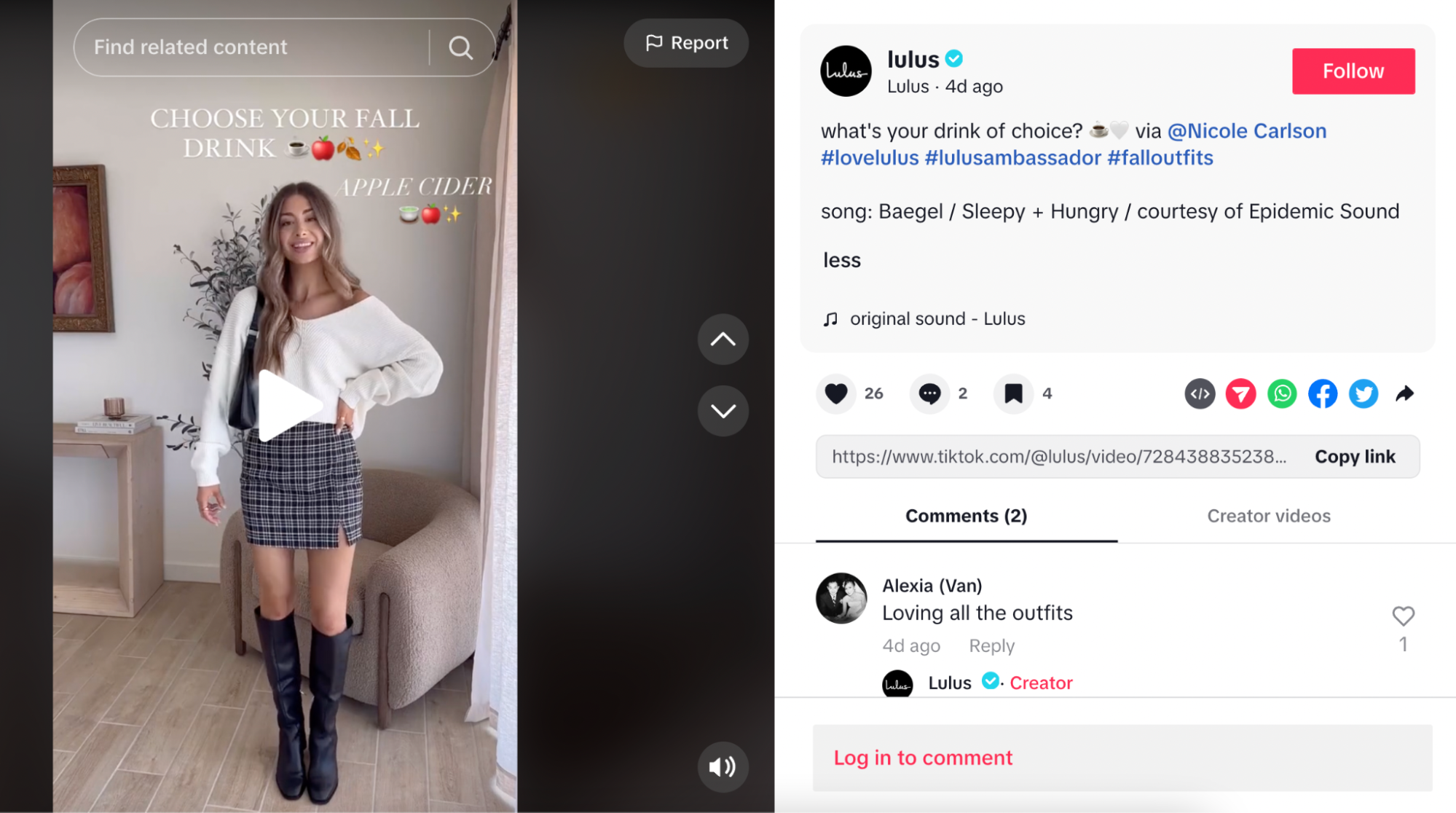
Building a hashtag campaign is a great way of encouraging customers to share images of your products in the hope of a feature in your feed. Plus, by using a branded hashtag, it’ll be easier to aggregate and choose from a large pool of UGC.
More brands will use AI-trained, payment-facilitator chatbots
If you’re not already offering live chat to social commerce customers, now’s the time. Some 41% of consumers surveyed by Shopify want live chat while shopping online. Social media platforms like Instagram are facilitating these discussions with “Get paid in chat”—a feature that allows brands to send customized checkout links to buy mid-conversation.
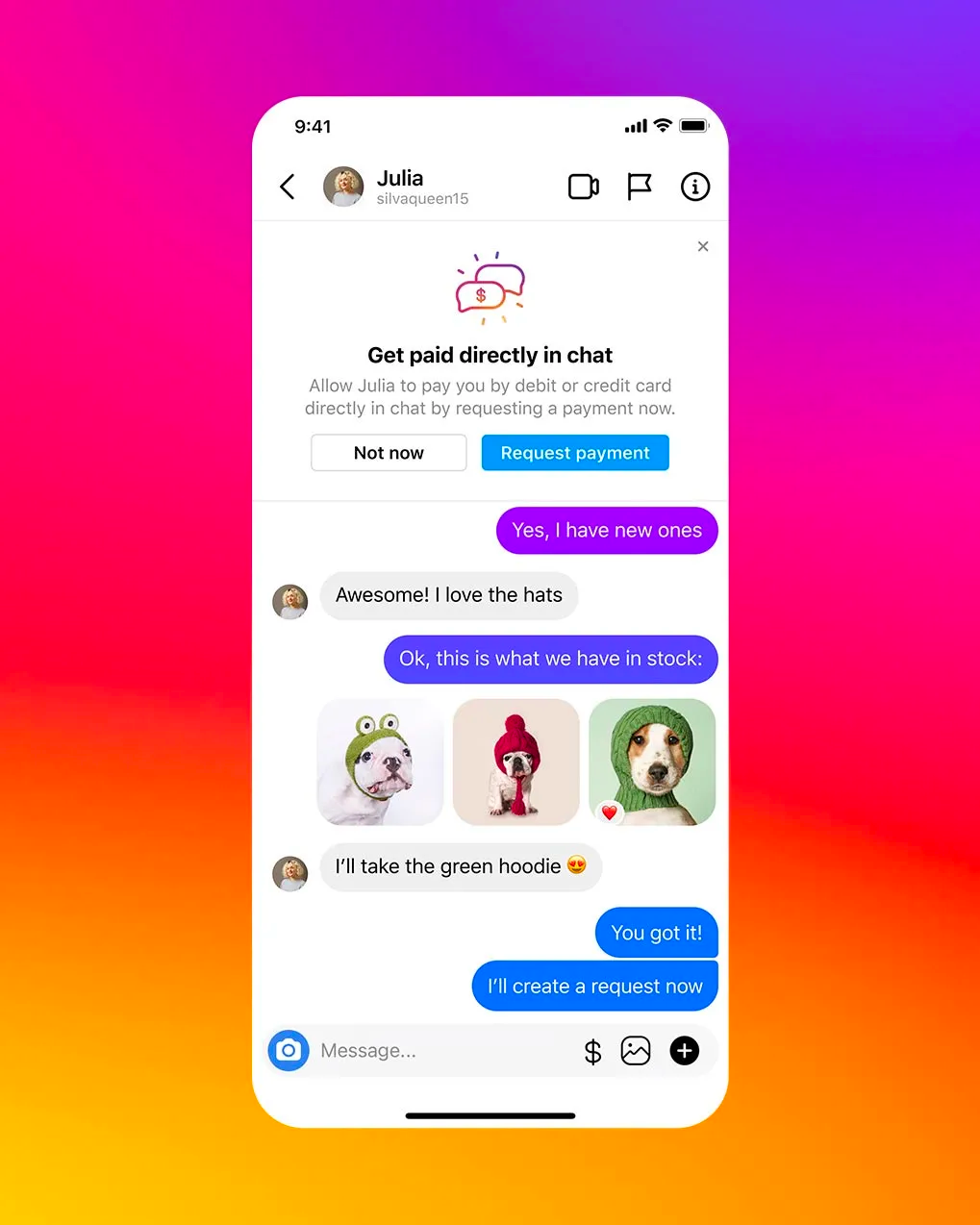
However you interpret that 41%, one thing’s clear: shoppers are demanding easy access to the brands they’re thinking about purchasing from. Social media—a place where real-time conversations with others are actively encouraged—is the perfect facilitator.
Live chat is one feature that helps make social commerce more sociable and interactive. Customers expect to interact with brands in the same way they chat with their friends: through social apps.
“More and more shoppers are going online to connect and interact authentically with the brands they like,” says Jared Pobre, cofounder of Caldera + Lab. “And creating that genuine engagement will require more than liking, commenting on, and sharing your followers’ posts.
“Brands will also need to implement one-on-one social media experiences with prospects through conversations in private messages. These messages can range from offering discounts on new products or promotions to post-purchase customer support. A more personalized engagement experience will make prospective buyers and new customers feel valued and assure them that your business is there when they need you.”
Frictionless social shopping experiences will boost customer loyalty
Social shopping makes it more convenient for customers to shop than traditional ecommerce. Brands need to focus on providing a seamless buyers’ journey in social shopping, so there’s less risk of shoppers becoming frustrated and leaving.
As more commerce brands turn to social channels to sell, brands will need to take care to create a compelling, easy-to-navigate social storefront. Consider replicating your website experience to provide familiarity, or curating top-performing products to feature on social media.
Remove unnecessary steps and streamline your full social commerce experience. If your business is eligible, add features like Instagram Checkout or one-tap purchase so customers can complete their purchase more easily without leaving the social media platform.
Stronger integrations between ecommerce and social commerce platforms
As social commerce becomes increasingly popular, ecommerce platforms are making it easier for retailers to integrate ecommerce and social commerce into your sales experience.
For instance, Shopify’s integration with Facebook and Instagram lets you automatically sync your Shopify product catalog to both social media platforms so you can create ads and shoppable posts. To bring the look and feel of your Shopify store to Facebook and Instagram Shops, group items together to help customers discover products.
Shopify and TikTok have also partnered to bring product links to Shopify merchants, which can be used to tag products in organic TikTok posts. The TikTok community can choose to shop directly from the merchant’s storefront or click a tagged product in a merchant’s TikTok video, which will take them to the merchant’s online store for checkout.
A YouTube partnership lets merchants pin products next to videos so followers can like, subscribe, and buy. There’s also a live-shopping feature designed to help retailers livestream on the social commerce platform.
“Shopify enabled us to migrate to a more sophisticated and stable tech stack, with apps that enable our virtual showrooms,” says Rob Bridgman, founder and CEO of furniture brand Snug. “Migrating has freed up time to focus on new channels like social commerce and live selling, so that we can pioneer in the furniture space as well as in the emerging marketing and technology space for retailers.”
Social commerce tips
Social commerce trends are constantly evolving, but there are a few best practices that you can look into for making the most out of selling through social commerce platforms.
1. Choose the right social commerce channel for your product
No single social media platform is best for every retailer, but if you want to know which is best for your business, consider the demographic makeup of your brand’s audience and start with the platform that most conforms to it.
For example, if you’re mostly marketing to Gen Z, you might consider using TikTok’s sales channels. If you’re selling to millennials, it might be better to start with Instagram.
If you’re already using social media to advertise your products, consider which social channels drive the most engagement currently. Social commerce can increase the volume of sales with a more frictionless checkout, but the same instincts that cause more users to engage with your content will be used to drive sales of your product.
While it’s possible to find audiences across multiple platforms, don’t fall into the trap of trying to do everything at once and spreading yourself too thin. Start by focusing on the most valuable social network, and plan to scale for the future.
2. Use your platform's livestreaming feature
Livestreaming can be a great way to showcase your product and talk about the unique selling proposition offered by your brand over competitors. For creators, a livestream can be a great way to show off your personality and build a deeper connection with your followers.
On a livestream, viewers can tune in, see your product in action, ask questions in real time, and get all the information they need to make a purchase. On Facebook, you can even activate live shopping, which gives them the option to purchase directly from your stream while they watch.
In 2023, livestreaming commerce accounted for 19.2% of retail ecommerce sales in China. Nearly all of China’s social platforms offer live shopping. Live shopping hasn’t caught on in the US just yet, with only 18% of people reportedly shopping via livestream. Yet as social commerce sales continue to grow, this format has higher potential to earn you sales.
3. Use instant messaging to engage with your customers
When you’re selling online, it’s likely that customers are going to have questions about your products. You can’t be live streaming 24/7, but you can keep your instant messaging channels open for fast and easy communication.
Live chat helps add a personal touch to your sales process and is a fast and convenient way to provide customer support. Being there for customers this way helps build up a familiarity with your brand in their minds that will translate into stronger brand loyalty and more sales. By being available via chat, you help curb the number of users who abandon their purchases.
Through private messaging, you can also offer discounts, promote new products, and nurture customer relationships following a purchase. The more personalized online shopping experience helps your customers feel more valued and lets them know you’re available to help.
4. Drive your growth by partnering with influencers
Influencer marketing has continued growing in popularity as a method of driving sales, with the industry set to balloon to $22.2 billion by 2025. Influencer audiences put a lot of value on the opinions of influencers they follow, so an endorsement can mean a huge boost to your online sales.
On top of that, the level of social engagement on your posts tends to increase when you work with influencers, since they often have very engaged audiences.
All that engagement plays well algorithmically too. When more users engage with your posts, there's a better chance of those posts being shown to new users who might be interested in your product.
And you don’t necessarily need to work with particularly large influencers in order for influencer marketing to be advantageous. Micro-influencers tend to have higher engagement rates than large influencers, which is more valuable for building a sustained, long-term engaged audience.
Stay ahead of the competition and tap into social commerce trends in 2024
These social commerce strategies and trends show that the market is only set to grow in 2024. As the number of active social media users rises, platforms will continue to release new features in an attempt to capture consumer spending.
To stand out in an increasingly crowded social commerce setting, brands need to tap into these trends. Find the social media channels your target audience uses, then build a strategy to interact with your ideal shoppers there.
Find influencers to drive sales with Shopify Collabs
Shopify Collabs makes it easy to partner with creators, promote your products, reach new customers, grow your sales, and track affiliate campaign performance all from Shopify admin.
Learn more about Shopify Collabs
Social Commerce FAQ
1. What is the meaning of social commerce?
Social commerce is the use of social media platforms to market and sell products and services. It lets users buy products within social platforms without exiting to another ecommerce website.
2. Is TikTok social commerce?
Yes, TikTok is a platform for social commerce. It lets users discover, promote, and buy products through content, influencer partners, and integrated shopping features. Businesses can directly sell products to consumers within the app.
3. What are the six features of social commerce?
- Live commerce
- Short-form video content
- Payment-enabled cahtbots
- Social media storefronts
- In-app purchases
- Community shopping
4. Which social commerce is most popular?
The most popular social commerce platform is Facebook. Some 49% of users are likely to make a purchase directly from the app. The second most popular social commerce is YouTube, followed by Instagram and TikTok.


